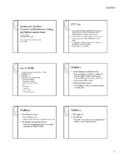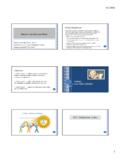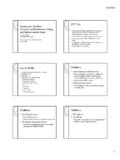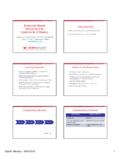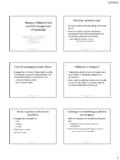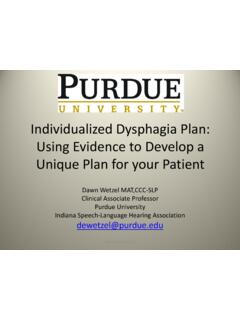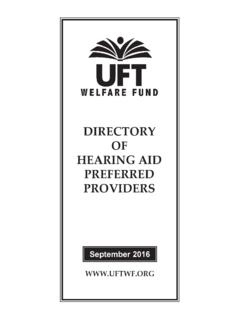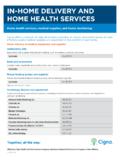Transcription of Understanding the Effects of Hearing Loss in the Classroom ...
1 9/21/2017. Understanding the Effects of Hearing Loss in the Classroom : A. practical guide for the educational SLP. Presented by Allison Winiger, AuD, CCC-A. Stephanie Wieczorek, AuD, CCC-A. September 23, 2017. Disclosures We are clinical assistant professors employed by IU Bloomington Both working full-time in the Indianapolis Public School (IPS) system Contract arrangement between IU and IPS that allows IU to use IPS as our exclusive clinical placement for graduate AuD students We are receiving an honorarium from ISHA for presenting today No other relevant disclosures Straight from the SLPs at IPS. Requested topics A review of the audiogram and the basics of Hearing loss The ways that Hearing loss can negatively impact a student TECHNOLOGY!
2 Specific questions When is it appropriate to dismiss a child with Hearing loss who is being seen for articulation of speech sounds they cannot hear well? Legally, what do we do when a child with a Hearing loss is being evaluated for special services but the family does not proceed with getting Hearing aids as recommended by their health care professionals? How do you determine between a contained Deaf/Hard of Hearing (DHH) preschool Classroom or a regular Classroom with accommodations when making placement decisions? What criteria must be met for a more restricted placement? 1. 9/21/2017. The Realities of Deaf/Hard of Hearing (DHH). Support Services in Indiana's Schools educational Audiologists are few and far between As of 9/17/17, only 10 professionals in the entire state belonged to the educational Audiology Association per their directory Many districts have chosen to contract services as needed Teachers of the Deaf (TODs) often cover multiple schools/districts As a result, children with Hearing loss often do not have immediate support at school when something goes wrong What do you do until help can arrive?
3 Who is qualified to assist? Is it better to step in, or should you wait for the AuD/TOD? What Role Should the SLP Play? ASHA Scope of Practice (2016). Auditory habilitation/rehabilitation, including auditory processing Collaboration with other professionals Prevention and wellness education, including Hearing -related topics Use of technology such as AACs Referrals to appropriate professionals as needed As professionals in the educational world, we have a responsibility to our students SLPs can be the daily eyes and ears for the AuD/TOD. You cannot share what you do not know Resources for an Audiology Refresher How do we hear? How do we test Hearing ? Interpreting the audiogram What are the types/degrees/configurations of Hearing loss?
4 2. 9/21/2017. Hearing Loss Hearing loss results from a breakdown in the auditory pathway and is categorized according to its type, degree, and configuration Common characteristics and challenges are associated with all types of Hearing loss Certain challenges are specific to particular Hearing losses, HOWEVER: having similar losses does NOT automatically imply similar experiences and outcomes for those children Hearing loss can affect both LOUDNESS and CLARITY of speech Different children have different strengths It is necessary to evaluate the child on an individual basis What Can the Student Hear? What does their loss sound like? simulated-listening-with- Hearing -loss-de vices/. The SLP's cheat sheet: speech banana Some audiograms have a speech banana superimposed on them The letters are located at their relative frequency and decibel level for conversational speech The child can hear letters located below the threshold line 3.
5 9/21/2017. Challenges in the Classroom Common challenges for students with Hearing loss Understanding speech in noise Understanding speech from far away or when the speaker is not facing them Listening fatigue Karen Anderson has created helpful handouts for various degrees and configurations of Hearing loss: Karen Anderson's Handouts Relationship of Hearing Loss to Listening and Learning Needs Child's Name: Date: HIGH FREQUENCY Hearing LOSS. Possible Impact on the Understanding of Possible Social Impact Potential educational Language and Speech Accommodations and Services Child can "hear" but can miss important May be accused of Student is at risk for educational fragments of speech. selective Hearing due to difficulties. discrepancies in speech Even a 26 40 dB loss in high frequency Hearing Depending upon onset, degree and Understanding in quiet may cause the child to miss 20%-30% of vital configuration of loss, child may versus noise.
6 Speech information if unamplified. experience delayed language and Social problems may syntax development and articulation Consonant sounds t, s, f, th, k, sh, ch likely heard arise as child problems. inconsistently, especially in the presence of noise. experiences difficulty Possible difficulty learning some May have difficulty Understanding faint or distant Understanding in noisy sound/letter associations in speech, such as a student with a quiet voice cooperative learning kindergarten and 1st grade classes. speaking from across the Classroom and will have situations, lunch or much greater difficulty Understanding speech recess. Early evaluation of speech and when in low background noise and/or language skills is suggested. May misinterpret peer reverberation is present.
7 Conversations. educational monitoring and teacher Many of the critical sounds for Understanding inservice is warranted. Child may be fatigued speech are high pitched, quiet sounds, making in Classroom due to Will typically benefit from personal them difficult to perceive; the words: cat, cap, greater listening effort. Hearing aids and use of a sound-field calf, cast could be perceived as "ca," word or a personal FM system in the endings, possessives, plurals and unstressed brief May appear inattentive, Classroom . words are difficult to perceive and understand. distractible or frustrated. Use of ear protection in noisy Speech production may be affected. situations is imperative to prevent Could affect self Use of amplification often indicated to learn damage to inner ear structures and concept.
8 Language at a typical rate and ease learning. resulting progression of the Hearing loss. Comments: Child's Name: Karen Anderson's Handouts Relationship of Hearing Loss to Listening and Learning Needs Date: UNILATERAL Hearing LOSS. Possible Impact on the Possible Social Impact Potential educational Understanding of Language and Accommodations and Services Speech Child can "hear" but can have difficulty Child may be accused of selective Allow child to change seat locations to Understanding in certain situations, such Hearing due to discrepancies in direct the normal Hearing ear toward the as Hearing faint or distant speech, speech Understanding in quiet primary speaker. especially if poor ear is aimed toward the versus noise. Student is at 10 times the risk for person speaking.
9 Social problems may arise as educational difficulties as children with 2. Will typically have difficulty localizing child experiences difficulty normal Hearing ears and 1/3 to 1/2 of sounds and voices using Hearing alone. Understanding in noisy cooperative students with unilateral Hearing loss The unilateral listener will have greater learning, or recess situations. experience significant learning problems. difficulty Understanding speech when May misconstrue peer Children often have difficulty learning environment is noisy and/or reverberant, conversations and feel rejected or sound/letter associations in typically especially when normal ear is towards ridiculed. noisy kindergarten and grade 1 settings. the overhead projector or other Child may be more fatigued in educational and audiological monitoring competing sound source and poor Classroom due to greater effort is warranted.
10 Hearing ear is towards the teacher. needed to listen, if class is noisy or Teacher inservice is beneficial. Exhibits difficulty detecting or has poor acoustics. Typically will benefit from a personal Understanding soft speech from the side May appear inattentive, FM system with low gain/power or a of the poor Hearing ear, especially in a distractible or frustrated, with sound-field FM system in the Classroom , group discussion. behavior or social problems especially in the lower grades. sometimes evident. Depending on the Hearing loss, may benefit from a Hearing aid in the impaired ear. Comments: 4. 9/21/2017. Karen Anderson's Handouts Relationship of Hearing Loss to Listening and Learning Needs Child's Name: Date: MID-FREQUENCY Hearing LOSS or REVERSE SLOPE Hearing LOSS.
